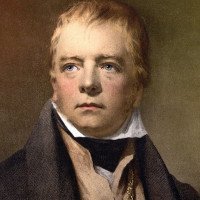Sir Walter Scott (1771-1832), Scottish writer and poet and one of the World’s greatest historical novelists was born on August 15 1771 in Edinburgh as the son of a solicitor Walter Scott and Anne, a daughter of a professor of medicine.
 An early illness of polio left him lame in the right leg, but he grew up to be a man over six feet and great physical endurance. Scott’s interest in the old Border tales and ballads had early been awakened, and he devoted much of his leisure to the exploration of the Border country and the Trossachs – particularly Loch Katrine where he wrote the acclaimed poem The Lady of the Lake. The Steamship that has operated on the loch since 1901 is named after him.
An early illness of polio left him lame in the right leg, but he grew up to be a man over six feet and great physical endurance. Scott’s interest in the old Border tales and ballads had early been awakened, and he devoted much of his leisure to the exploration of the Border country and the Trossachs – particularly Loch Katrine where he wrote the acclaimed poem The Lady of the Lake. The Steamship that has operated on the loch since 1901 is named after him.
He attended Edinburgh High School and studied at Edinburgh University arts and law. Scott was apprenticed to his father in 1786 and in 1792 he was called to the bar. In 1799 he was appointed sheriff depute of the county of Selkirk.
In 1797 Scott married Margaret Charlotte Charpenter. They had five children.
Scott has been credited with rescuing the Scottish banknote. In 1826, there was outrage in Scotland at the attempt of Parliament to prevent the production of banknotes of less than five pounds. Scott wrote a series of letters to the Edinburgh Weekly Journal under the pseudonym “Malachi Malagrowther” for retaining the right of Scottish banks to issue their own banknotes. This provoked such a response that the Government was forced to relent and allow the Scottish banks to continue printing pound notes. This campaign is commemorated by his continued appearance on the front of all notes issued by the Bank of Scotland.
In Scotland there are many places that commemorate Sir Walter Scott. In Edinburgh’s Princes Street there is the 61m high Scott Monument and in Glasgow the Walter Scott’s Monument dominates George Square in the centre of the City.
The Scott Monument Edinburgh: “Its purity as a Gothic monument, and more particularly the constructive skill exhibited throughout, in the combination of graceful features of that style of architecture. the composition and in the perfect solidity which it would possess when built”.
There are 287 steps to the top of the Scott Monument, from where you can enjoy breathtaking views of Edinburgh and the surrounding countryside.
Open from April until September: Monday to Sunday 10am – 7pm
October until March: Monday to Sunday 10am – 4pm; last admission 3.30pm.
